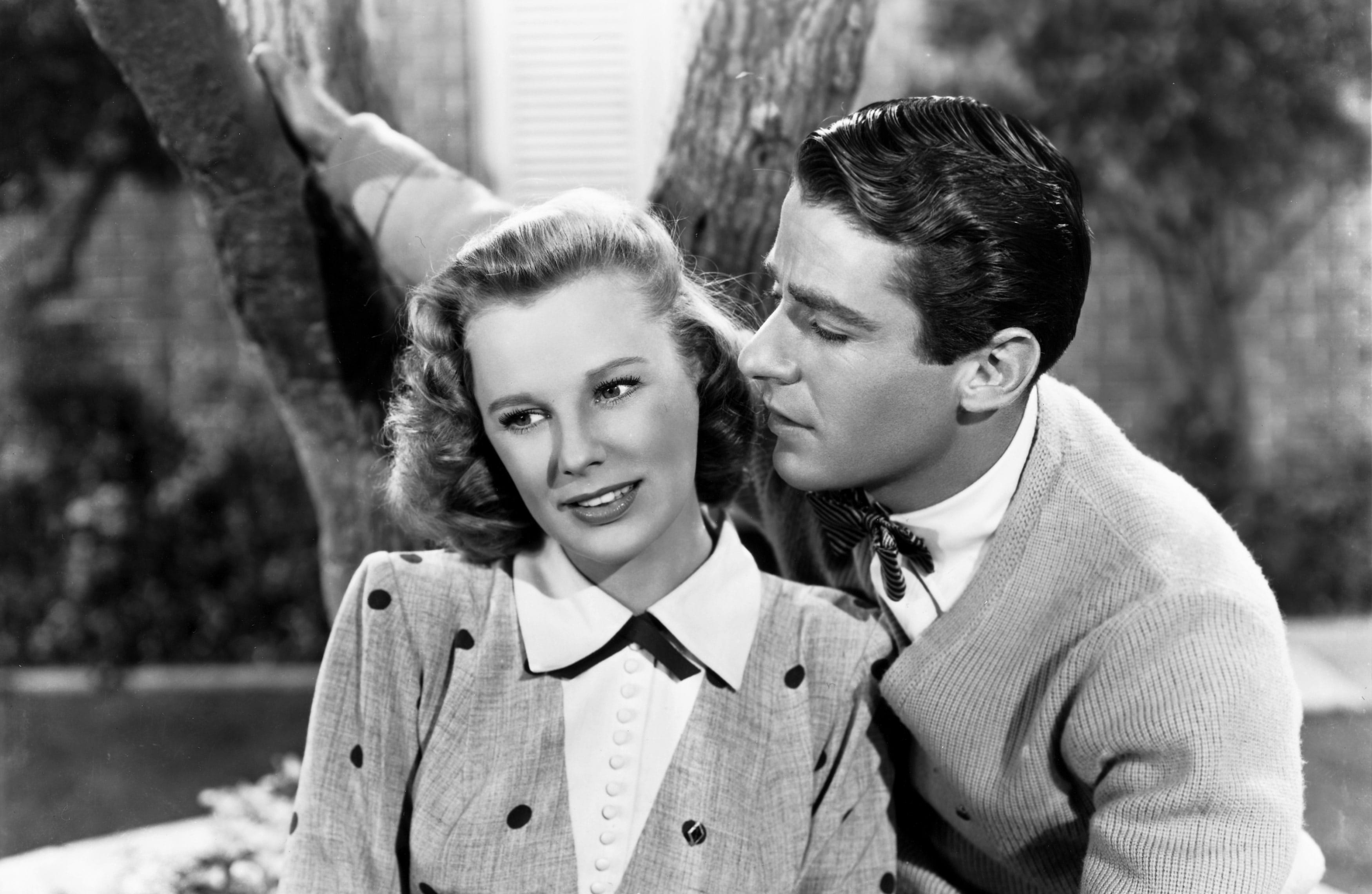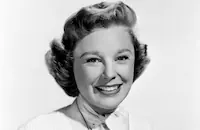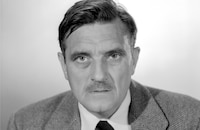Good News

Brief Synopsis
Cast & Crew
Charles Walters
June Allyson
Peter Lawford
Patricia Marshall
Joan Mccracken
Ray Mcdonald
Film Details
Technical Specs

Synopsis
In 1927, Pat McClellan, having just completed finishing school, arrives at Tait College to begin her studies and pledge at the Phi Gamma Gamma sorority. Pat's arrival causes quite a stir on campus, and she exploits the attention by making a showy display of her newly acquired sophistication. She wins the immediate adoration of the players on the school football team, but Connie Lane, one of her fellow sorority sisters, sees through her French-speaking pretensions and is disgusted by her vanity. Connie, who works part-time at the university library, disapproves of the slinky red dress that Pat intends to wear to the upcoming sorority party and tells her that the dress is too "extreme and obvious." Pat, however, ignores Connie's advice, and makes a splashy entrance at the party, attracting the notice of all the male students, including Tommy Marlowe, the captain of the football team. Pat deliberately ignores Tommy, and instead pursues Peter Van Dyne, III, simply because he comes from a well-to-do family. Pat's rejection makes Tommy want her all the more, and he vows to learn French to be able to converse with her in her preferred language. Connie is secretly in love with Tommy, and though she is disappointed in his determination to attract Pat, she consents to tutor him in French. Tommy learns how to speak French well enough to ask Pat to the prom in French, but he is crushed when Pat turns down his invitation. When Babe Doolittle, Connie's roommate, learns of the rejection, she decides, for the sake of the football team, to intervene and prevent Tommy from becoming depressed. As part of her plan, Babe tries to interest Pat in Tommy by telling her that Tommy is the heir to his family's pickle fortunes. Pat's interest in Tommy is suddenly piqued, but Tommy, meanwhile, has asked Connie to the prom. Connie is overjoyed that Tommy has asked her to be his date, but her excitement is dashed in an instant when Tommy tells her he is going with Pat. As Tommy's grades begin to slip, Coach Johnson grows increasingly concerned that Tommy will not have the high marks he needs to play in the big game against Colton University. With Tommy's football-playing future at stake, Johnson and others implore Connie to rescue Tommy and coach him for a re-examination in his French class. Connie reluctantly agrees to the arrangement, and, to her astonishment, Tommy makes romantic overtures to her during their first lesson. After admitting to Connie that his interest in Pat was a mistake, Tommy tries to get out of his promise to announce his engagement to Pat by deliberately failing the French test and forcing his own suspension from the big football game. Despite his attempts to stay out of the game and avoid his commitment to Pat, Tommy is forced to play. As a result, Tommy plays poorly and the team suffers greatly. During the game, Connie gets an idea to save the team from defeat by telling Pat that Tommy has suddenly become penniless. Connie's plan works, and when Tommy learns that Pat has left him, he delivers a victory for the team and looks forward to an unimpeded romance with Connie.

Director

Charles Walters
Cast

June Allyson

Peter Lawford
Patricia Marshall
Joan Mccracken

Ray Mcdonald
Mel Torme

Robert Strickland

Donald Macbride
Tom Dugan

Clinton Sundberg
Loren Tindall

Connie Gilchrist

Morris Ankrum
Georgia Lee
Jane Green
Anne Taylor
Mary Stuart
Janet Winkler
Helen Chapman
Arthur Walsh
Bill Harbach
Joe Strauch Jr.
Duff Whitney
John Garrett
Sarah Edwards
Wheaton Chambers
The Williams Brothers
Crew
Albert Akst
Ralph Blane
Bobby Bonner
Hugh Boswell
Jack Boyle
Lew Brown
Charles Burrell
Emilio Calori
Frank Capacchione
Paul G. Chamberlain
Betty Comden
Betty Comden
Kerwin Coughlin
Aggie-lou Coulson
Jack Dawn
B. G. De Sylva
Grace Devore
George Dye
Roger Edens
Roger Edens
Al Eiseman
Freddie Faust
Jack Franzen
Arthur Freed
Myrtle Gallagher
Cedric Gibbons
James Gooch
Adolph Green
Adolph Green
Sydney Guilaroff
Lennie Hayton
Ray Henderson
Chuck Hughes
Patt Hyatt
Eylla Jacobus
Henri Jaffa
Al Jennings
Conrad Kahn
Natalie Kalmus
Harry Kress
Jimmy Manatt
Dave Marks
Hugh Martin
Jimmy Mathews
John Miller
Richard Neblett
Ethel Neefus
Perry O'brien
Helen Rose
Bill Ryan
Charles Schoenbaum
Charlie Schram
Gaius Shaver
Douglas Shearer
Lela Simone
Kay Thompson
Tommy Thompson
Bill Tuttle
Valles
Bobby Webb
Edwin B. Willis

Photo Collections
Videos
Movie Clip


Trailer
Hosted Intro
Film Details
Technical Specs

Award Nominations
Best Song
Articles
Good News (1947)
Good News (1947) is not a movie which is often written about or even remembered today, which makes it a total delight to discover for the first time. It's an unpretentious, colorful, simple little musical which thankfully never tries to be grand or overblown; the subject matter - a frothy college campus story - just wouldn't support that kind of weight. In fact, the story is flat-out ridiculous. Peter Lawford is a football hero who can't make his grades, so June Allyson, who's working her way through college as a librarian, tutors him in French and falls for him in the process. Patricia Marshall, meanwhile, plays the college sexpot who wants Lawford for herself. Can Lawford pass French, win the big game and wind up with the right girl? The answers may be obvious, but the story is completely serviceable as an excuse for some charming song-and-dance numbers.
College musicals were extremely popular in the early studio era, and Good News was one of the best. It began as a 1927 stage hit and was first filmed in 1930, starring Bessie Love. For the 1947 version, MGM's "Freed Unit" took the reigns. Arthur Freed had recently racked up some pretty impressive producing credits, including Babes in Arms (1939), For Me and My Gal (1942), Meet Me in St. Louis (1944), and The Harvey Girls (1946). (Still in the future lay On the Town (1949), The Band Wagon (1953) and other hits). For this remake Freed hired Betty Comden and Adolph Green to update the script - their first screen credit of a career that would soon include Singin' in the Rain (1952). The property already had some good songs, including "The Best Things in Life Are Free," but Freed brought on Hugh Martin and Ralph Blane to add a couple of new ones: "The French Lesson" and "Pass That Peace Pipe," the latter of which featured a sensational Joan McCracken dance routine and went on to earn an Oscar nomination. (It lost to "Zip-A-Dee-Doo-Dah," from Disney's Song of the South, a film which is sadly unavailable in today's politically correct climate.)
Making his directorial debut was Charles Walters, who had entered the movies as a choreographer and had earned this big break. He acquitted himself nicely: Good News was a huge hit. Freed was happy ("It made nothing but money!" he said of the film) and rewarded Walters with the reigns to Easter Parade (1948), a serious step up in terms of stars and prestige.
Good News also cemented husky-voiced June Allyson as a star. (The huskiness was caused by chronic bronchitis and enlarged vocal chords.) Born Ella Geisman, Allyson had started her Hollywood career in the middle of WWII, a time in which her image of wholesomeness was something the public wanted to see, especially when she was paired with that bobby-soxers' delight, Van Johnson. Louis B. Mayer wanted the pair to date, in fact, because it would create good publicity for the MGM machine, and they did go out on a few arranged dates. But June and Van were already extremely close friends - like a brother and sister - and they just laughed at the absurdity of it all. To Mayer's dismay, Allyson fell in love with Dick Powell (or as she called him, Richard), who was going through a divorce. Eventually, not only did Allyson and Powell marry, in 1945, but Louis B. Mayer gave away the bride. They divorced in 1961, reunited a few months later, and then Powell died of cancer in 1963.
Regarding Good News, "Everything about the movie was unbelievable," Allyson wrote in her memoirs. "No one made any effort to change Peter Lawford's British accent to American. For that matter, my French accent was atrocious and his was superb - he spent hours teaching me how to teach him French. Working with Peter Lawford was like going to a party. He made a game of whatever he did." But according to Lawford biographer James Spada, the young actor was extremely nervous about this role - his biggest to date - and he worked tremendously hard to pull off the required singing and dancing. This prompted amazement from his old dance teacher back East, who had tried in vain to teach him proper rhythm. She said, "Anybody who could teach that boy to sing and dance in time has got to be a genius."
Allyson and Lawford made a good team. They had already worked together on Two Sisters from Boston (1946) and would appear together in two later films: Little Women (1949) and They Only Kill Their Masters (1972).
Producer: Arthur Freed
Director: Charles Walters
Screenplay: Betty Comden, Adolph Green, Buddy G. DeSylva (play), Ray Henderson (play), Frank Mandel (play), Laurence Schwab (play)
Cinematography: Charles E. Schoenbaum
Film Editing: Albert Akst
Art Direction: Edward C. Carfagno, Cedric Gibbons
Music: Ralph Blane, Buddy G. DeSylva, Roger Edens, Ray Henderson, Hugh Martin
Cast: June Allyson (Connie Lane), Peter Lawford (Tommy Marlowe), Patricia Marshall (Pat McClellan), Joan McCracken (Babe Doolittle), Ray McDonald (Bobby Turner), Mel Tormé (Danny).
C-94m. Closed captioning.
by Jeremy Arnold

Good News (1947)
Quotes
Trivia
Since Peter Lawford spoke French fluently and June Allyson did not, Lawford had to teach Allyson how to teach him to speak French in the French Lesson scene.
Notes
This film marked the directorial debut of Charles Walters, a former actor and dancer who had previously worked as a dance director on several M-G-M films of the early 1940s. The film also marked the first screenplay written by Betty Comden and Adolph Green, who began their long collaboration first as performers when they formed the group "The Revuers" with singer/comedian Judy Holliday. The Revuers were seen was very briefly seen in the 1944 Twentieth Century-Fox film Greenwich Village (see below). Comden and Green went on to write a number of popular Broadway and film musicals, including On the Town (see below).
Pre-production news items in Hollywood Reporter indicate that actress Gloria De Haven was originally set for the part played by Patricia Marshall, a stage actress who made her motion picture debut in the film. While a March 7, 1947 Hollywood Reporter news item noted that De Haven had been dropped from the cast due to "differences over the script," a news item appearing in Hollywood Reporter two weeks later announced that De Haven refused the role and, as a result, was dropped from the M-G-M talent roster. De Haven was suspended for only a brief time, however, and went on to appear in several M-G-M films. Actor Jackie Cooper was tested for a role in February 1947, but he was not cast in the picture. A song entitled "An Easier Way," by Roger Edens, Betty Comden and Adolph Green, was deleted from the film before its release. The cut song, sung by June Allyson, was preserved, however, and was shown on the Turner Classic Movie channel as part of a marathon screening of M-G-M musicals, with songs that were cut from them.
Good News opened to generally favorable reviews, although the New York Times reviewer noted Peter Lawford's weakness as a dancer and singer and wrote that Allyson "can't sing worth a fig." (In fact, singer Patt Hyatt dubbed the songs "Just Imagine" and "The Best Things in Life are Free" for Allyson.) Roger Edens, Ralph Blane and Hugh Martin received an Academy Award nomination for the song "Pass The Peace Pipe," which was not in the Broadway musical version of Good News and was originally written for the film Ziegfeld Follies (see below). A biography of director and lyricist Arthur Freed provides the following information about the film: Robert Alton staged the film's two production numbers. Van Johnson was initially cast in the role of "Tommy Marlowe," and Mickey Rooney was considered for the part before it went to Lawford. Lawford protested his assignment to the film, arguing that his English accent would be inappropriate for the part of an American college student. The film was completed under budget, at a final cost of $1,666,718, and grossed nearly $3,000,000 in its initial release.
Good News was the second M-G-M adaptation of the Broadway musical. The first adaptation, in 1930, was directed by Nick Grinde and starred Mary Lawlor and Stanley Smith (see AFI Catalog of Feature Films, 1921-30; F2.2190). Although a June 1943 Hollywood Reporter news item announced that producer Sam Coslow planned a revamped and updated version of the 1930 film, that project was never made.
















